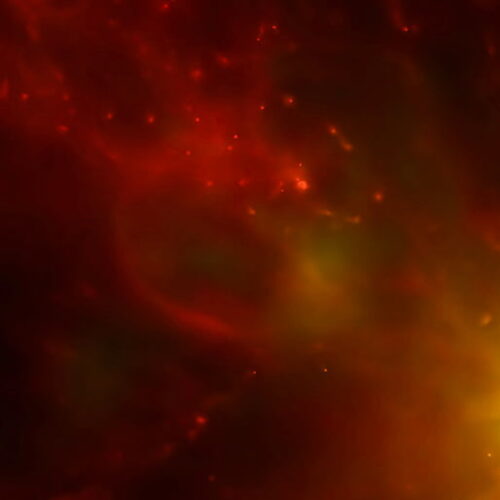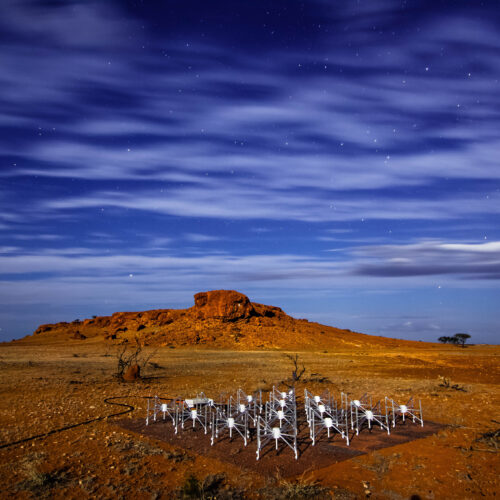ICRAR’s science program is based on the instinctive human endeavour to understand more about the nature of everything around us.
Making sense of the information from new generation telescopes such as the Australian Square Kilometre Array Pathfinder (ASKAP), the Murchison Widefield Array (MWA) and the Square Kilometre Array (SKA) will vastly expand our view and understanding of the Universe. By attracting a diverse team of world-class researchers and collaborating with other leading institutions, ICRAR has grown into an internationally-renowned centre of astronomy research since its inception in 2009. We have published over 1800 peer-reviewed journal articles.
ICRAR’s Peer-reviewed Publications
Science Focus
Our science programme is divided across ICRAR’s two nodes, Curtin and UWA, although some of our projects involve a high level of collaboration between the two nodes. Curtin’s key focuses are extragalactic radio science, accretion physics and slow transients, the epoch of reionisation, and pulsars/fast transients. Our UWA node is studying galaxies in the local and distant Universe, and cosmological theory. The overall program combines large observational programmes with large theoretical simulations to explore the Universe and pave the way for exciting SKA science.
Extragalactic Radio Science
Project lead: Dr Natasha Hurley-Walker
This project exploits the superb multi-frequency survey capabilities of the Murchison Widefield Array in order to conduct novel extra-galactic science with particular focus on:
- Characterising radio clusters and the cosmic web;
- Unravelling the astrophysics of the life-cycles of radio galaxies and tracing their evolution across cosmic time; and
- Using the phenomenon of inter-planetary scintillation over large areas to study distant radio galaxies and learn about the solar wind.
Case study: GLEAM
Accretion Physics and Slow Transients
Project lead: Prof James Miller-Jones
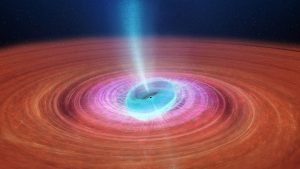
Artist’s impression of the inner parts of the accretion disk in V404 Cygni. The black hole rotates about a different axis to the binary orbit. As the spinning black hole drags spacetime around with it, the puffed-up inner accretion disk wobbles around like a spinning top. The jets launched from the innermost parts of the flow are redirected, either by the puffed-up inner disk or the strong winds being driven off it by the intense radiation. Credit: ICRAR
Short-lived explosive events such as the deaths of massive stars, or the outbursts caused by a black hole feeding on a normal star, provide excellent laboratories for studying high-energy astrophysics, allowing us to probe energies, magnetic fields, and strong gravity that can never be reproduced here on Earth. This project uses radio telescopes (including the precursor facilities to the Square Kilometre Array) to characterise the jets and outflows produced in these extreme environments, determining how they are launched and how they feed back energy to their surroundings. This work benefits from the advent of multi-messenger astronomy, using gravitational waves, neutrinos, and high-energy gamma-rays to provide new windows into these cosmic cataclysms. Finally, the project uses the techniques developed for the study of transient astrophysical events to develop the Murchison Widefield Array’s capabilities for detecting and tracking objects in low-Earth orbit.
Fast Transients and Pulsars
Project lead: Dr Ramesh Bhat
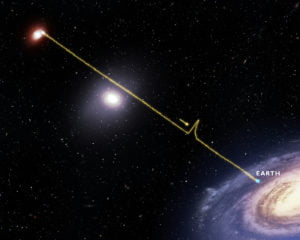
An artist’s impression of Fast Radio Burst 181112 travelling through the halo of a galaxy 4 billion light-years from Earth. Credit: © J. Josephides, Centre for Astrophysics and Supercomputing, Swinburne University of Technology.
The impulsive emission from pulsars and short-timescale transients, such as fast radio bursts, is associated with the most energetic and brightest single events in the Universe. This emission represents Nature’s ultimate laboratory, since it is usually generated by matter under extreme conditions whose properties probe physical regimes that far transcend the range achievable in terrestrial experiments. Our objectives are to both understand the physics behind these phenomena and to use them as lighthouses to probe the Universe through which their ultra-luminous emission propagates. We are using fast radio bursts to weigh the Universe and to probe the very properties of space-time over a large range of the Universe’s history.
We are using fast radio bursts to weigh the Universe to probe the properties of space-time over a large range of the Universe’s history, and pulsars as astrophysical tools for testing strong-field gravity and as detectors of gravitational waves.
Physics of the Diffuse Universe
Project lead: Dr Tobias Westmeier
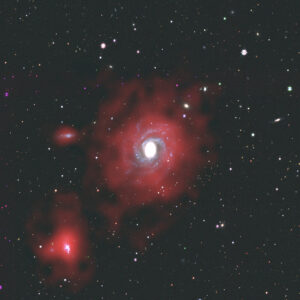
View of the spiral galaxy NGC 4897 and two nearby dwarf galaxies. This image combines an optical photo of the stars in white and blue colours with radio astronomical data showing the neutral hydrogen gas in red colour. Image credit: Legacy Surveys / D. Lang (Perimeter Institute) / T. Westmeier (ICRAR).
Our group investigates how gas flows into, through, and out of galaxies—key processes that regulate star formation and drive galaxy evolution. We study the multiphase interstellar medium (ISM) in nearby galaxies, with an emphasis on the neutral atomic component traced by 21 cm emission. Our work is anchored by two major surveys with the Australian Square Kilometre Array Pathfinder (ASKAP): WALLABY, which provides a panoramic view of HI in the local Universe, and DINGO, which probes deeper to explore how gas content evolves over time. These surveys will detect HI in more than a hundred thousand galaxies, offering new insights into how gas shapes galaxy evolution and transforming our understanding of the cosmic gas cycle.
To build a comprehensive picture of the ISM and the star formation cycle, we integrate HI data with multi-wavelength observations that trace different phases of the gas. An example of this is MAUVE, a large program targeting Virgo cluster galaxies with optical integral-field spectroscopy and high-resolution ALMA observations of molecular gas. This allows us to resolve gas flows on scales of tens of parsecs and directly connect large-scale environmental processes to the internal physics of star formation.
We also collaborate on complementary international programs that extend our view of the ISM to different environments, redshifts, and spatial resolutions—for example, the deep HI survey LADUMA with South Africa’s MeerKAT telescope, and large-scale mapping efforts with China’s FAST. Together, these efforts place Australia at the forefront of extragalactic HI science and lay the groundwork for leadership in future SKA Key Science Projects.
The Evolving Universe
Project lead: Prof Aaron Robotham
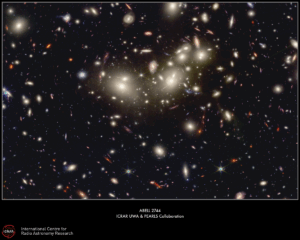
An image from NASA’s James Webb Space Telescope, as processed by the team at ICRAR/UWA. Credit: ICRAR/UWA and the PEARLS team.
The Evolving Universe group is focussed on understanding how galaxies have grown, merged and died over cosmic timescales. To this end our team pursue a number of complementary approaches: large surveys combining images with spectra to determine the 3D map of the Universe (surveys like GAMA, DEVILS and WAVES); detailed studies of the physical structure and movement of galaxies using integral field spectrographs (surveys like MAGPI and MAUVE); and very deep studies of high redshift targets to better understand galaxies when they first formed (surveys like PEARLS, SkySurf, CRISTAL).
A common thread to all of our research efforts in the evolving Universe group is that we combine a broad spectrum of data to achieve maximum insight from the leading facilities at all wavelengths. This means we have some of the world leading experts in ultraviolet, optical, near infrared, far infrared, sub-mm/mm and radio data all working to a common goal: understanding the physics that drives galaxies to evolve over billions of years. Much of the work carried out in the Evolving Universe group requires Big Data analytics and deep theoretical insight, and many of our team members lead some of the largest surveys on the best facilities in the world (JWST, ALMA, VLT, 4MOST, ASKAP). We are also collectively engaged in developing next generation surveys and driving the technology of the facilities of the future (SKA, WST).
If you have an interest in how galaxies evolve, how data is collected and processed, how physics and statistics can be combined to learn about the Universe, then somebody in our group will be interested to talk!
Cosmological Theory
Project lead: Associate Professor Claudia Lagos
The Cosmological Theory group aims to understand how galaxies and more generally structures in the universe formed and evolved into what we observe today from cutting edge telescopes on the ground and space. We use a variety of techniques, from pure theory to complex software that requires large supercomputers to run, also exploiting the latest developments in Artificial Intelligence to advance our understanding of what works and doesn’t in our current theories. We make extensive use of Australia’s computing facilities, including the Pawsey supercomputer in Western Australia and the National Computer Infrastructure in Canberra.
Our broad goal is to understand: (I) how our Milky-Way and its satellites formed; (II) how the population of galaxies formed in a universe that is dominated by dark matter and dark energy; (III) how the nature of dark matter affects the formation of structures in the universe; and (IV) how physical processes internal to galaxies (such as star formation, massive star explosions, supermassive black hole growth and energy output, etc) affect their evolution. We have led several large projects, including the SURFS (Synthetic UniveRses For Surveys) suite of dark matter simulations, the development of the semi-analytic model of galaxy formation Shark, and a suite of detailed Milky-Way galaxy simulations, to mention a few.
We also have a large network of collaborators in Australia and abroad with whom we work to develop ever larger simulations of the universe, including Melbourne University, ANU, Leiden University, Durham University, Universidad Autónoma de Madrid, University of Nottingham, etc.
Epoch of Reionisation
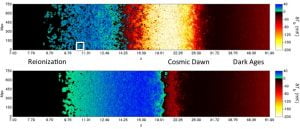
Two different possible evolutionary paths of neutral gas in the Universe. These paths are being probed by low-frequency radio telescopes, such as the Murchison Widefield Array. Image courtesy of Andrei Mesinger.
Project lead: A/Prof Cathryn Trott
The Epoch of Reionisation project explores the first billion years of the Universe, as probed through the redshifted emission line of neutral hydrogen gas. Studying the spatial and temperature distribution of the neutral hydrogen gas between the first galaxies provides key insights into the growth of structure at the Cosmic Dawn, and the first sources of ionising radiation in the Universe. We are exploring the spatial nature of this signal with the Murchison Widefield Array (MWA), and future Square Kilometre Array (SKA), and also pursuing the globally-averaged signal with short-spacing interferometers. Beyond the observational data, we also explore the astrophysical interpretation of the signal, and develop and apply new tools to observing this era of the Universe.
